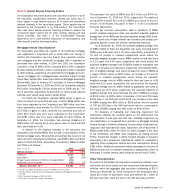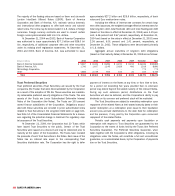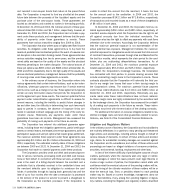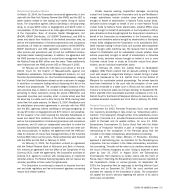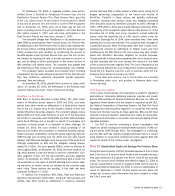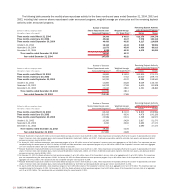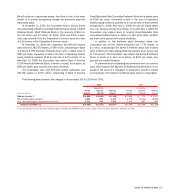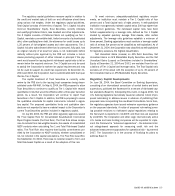Bank of America 2004 Annual Report Download - page 126
Download and view the complete annual report
Please find page 126 of the 2004 Bank of America annual report below. You can navigate through the pages in the report by either clicking on the pages listed below, or by using the keyword search tool below to find specific information within the annual report.
BANK OF AMERICA 2004 125
respectively. The carrying amount for these commitments, which repre-
sents the liability recorded related to these instruments, at December
31, 2004 and 2003 was $520 million and $418 million, respectively.
December 31 FleetBoston
(Dollars in millions) 2004 2003 April 1, 2004
■■■■■■■■■
Loan commitments(1) $247,094 $180,078 $ 61,012
Home equity lines of credit 60,128 31,703 13,891
Standby letters of credit and
financial guarantees 42,850 31,150 12,914
Commercial letters of credit 5,653 3,260 1,689
■■■■■■■■■
Legally binding commitments 355,725 246,191 89,506
Credit card lines 185,461 93,771 77,997
■■■■■■■■■
Total $541,186 $339,962 $167,503
■■■■■■■■■
(1) Equity commitments of $2,052 and $1,678 related to obligations to fund existing equity
investments were included in loan commitments at December 31, 2004 and 2003, respectively.
Included in loan commitments at December 31, 2004, were $838 of equity commitments
related to obligations to fund existing equity investments acquired from FleetBoston.
Legally binding commitments to extend credit generally have speci-
fied rates and maturities. Certain of these commitments have
adverse change clauses that help to protect the Corporation against
deterioration in the borrowers’ ability to pay.
The Corporation issues SBLCs and financial guarantees to sup-
port the obligations of its customers to beneficiaries. Additionally, in
many cases, the Corporation holds collateral in various forms against
these SBLCs. As part of its risk management activities, the
Corporation continuously monitors the creditworthiness of the cus-
tomer as well as SBLC exposure; however, if the customer fails to per-
form the specified obligation to the beneficiary, the beneficiary may
draw upon the SBLC by presenting documents that are in compliance
with the letter of credit terms. In that event, the Corporation either
repays the money borrowed or advanced, makes payment on account
of the indebtedness of the customer or makes payment on account
of the default by the customer in the performance of an obligation to
the beneficiary up to the full notional amount of the SBLC. The cus-
tomer is obligated to reimburse the Corporation for any such pay-
ment. If the customer fails to pay, the Corporation would, as
contractually permitted, liquidate collateral and/or set off accounts.
Commercial letters of credit, issued primarily to facilitate cus-
tomer trade finance activities, are usually collateralized by the under-
lying goods being shipped to the customer and are generally
short-term. Credit card lines are unsecured commitments that are not
legally binding. Management reviews credit card lines at least annu-
ally, and upon evaluation of the customers’ creditworthiness, the
Corporation has the right to terminate or change certain terms of the
credit card lines.
The Corporation uses various techniques to manage risk
associated with these types of instruments that include collateral
and/or adjusting commitment amounts based on the borrower’s
financial condition; therefore, the total commitment amount
does not necessarily represent the actual risk of loss or future
cash requirements. For each of these types of instruments, the
Corporation’s exposure to credit loss is represented by the
contractual amount of these instruments.
Other Commitments
At December 31, 2004 and 2003, charge cards (nonrevolving card
lines) to individuals and government entities guaranteed by the U.S.
government in the amount of $10.9 billion and $13.7 billion, respec-
tively, were not included in credit card line commitments in the previ-
ous table. The outstandings related to these charge cards were $205
million and $233 million, respectively.
At December 31, 2004, the Corporation had whole mortgage
loan purchase commitments of $3.3 billion, of which $2.9 billion will
settle in January 2005, and $430 million will settle in February 2005.
At December 31, 2003, the Corporation had whole mortgage loan
purchase commitments of $4.6 billion, all of which were settled in
January and February 2004. At December 31, 2004 and 2003, the
Corporation had no forward whole mortgage loan sale commitments.
The Corporation has entered into operating leases for certain of
its premises and equipment. Commitments under these leases
approximate $1.4 billion in 2005, $1.1 billion in 2006, $995 million
in 2007, $854 million in 2008, $689 million in 2009 and $3.4 bil-
lion for all years thereafter.
Other Guarantees
The Corporation sells products that offer book value protection pri-
marily to plan sponsors of Employee Retirement Income Security Act
of 1974 (ERISA)-governed pension plans such as 401(k) plans, 457
plans, etc. The book value protection is provided on portfolios of
intermediate/short-term investment grade fixed income securities
and is intended to cover any shortfall in the event that plan partici-
pants withdraw funds when market value is below book value. The
Corporation retains the option to exit the contract at any time. If the
Corporation exercises its option, the purchaser can require the
Corporation to purchase zero coupon bonds with the proceeds of the
liquidated assets to assure the return of principal. To hedge its expo-
sure, the Corporation imposes significant restrictions and constraints
on the timing of the withdrawals, the manner in which the portfolio is
liquidated and the funds are accessed, and the investment parame-
ters of the underlying portfolio. These constraints, combined with
structural protections, are designed to provide adequate buffers and
guard against payments even under extreme stress scenarios. These
guarantees are booked as derivatives and marked to market in the
trading portfolio. At December 31, 2004 and 2003, the notional
amount of these guarantees totaled $26.3 billion and $24.9 billion,
respectively, with estimated maturity dates between 2006 and 2034.
As of December 31, 2004 and 2003, the Corporation has not made
a payment under these products, and management believes that the
probability of payments under these guarantees is remote.
The Corporation also sells products that guarantee the return of
principal to investors at a preset future date. These guarantees cover
a broad range of underlying asset classes and are designed to cover
the shortfall between the market value of the underlying portfolio and
the principal amount on the preset future date. To manage its expo-
sure, the Corporation requires that these guarantees be backed by
structural and investment constraints and certain pre-defined triggers
that would require the underlying assets or portfolio to be liquidated




